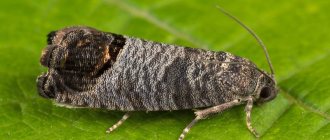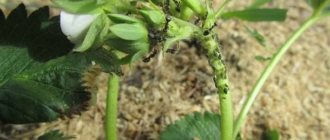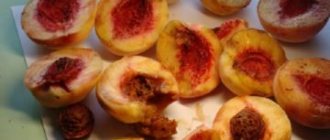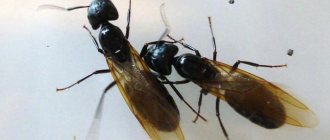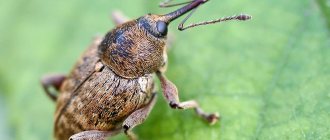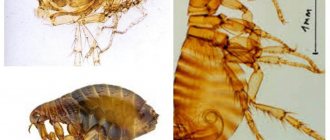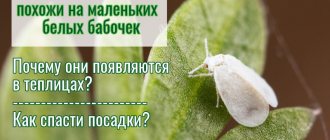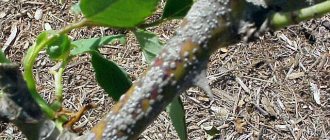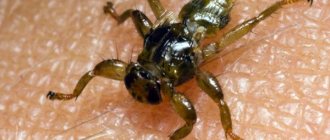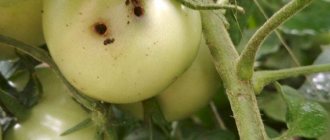Those caterpillars that eat apples are moths . And these are the most common and dangerous pests (since there are several types of them).
The most common are apple and oriental. These are butterflies whose larval stage feeds on both the pulp and seeds of the growing apple tree fruit. What causes its early fall and rapid decay. During a pest outbreak, up to ¾ of the entire apple harvest may be lost. In this article we will tell you how to save an apple tree from the codling moth .
Symptoms and characteristics of the insect
Symptoms of damage are increased flight of butterflies 12-17 days after flowering, as well as the presence of 1 to 5 or more microscopic holes on apple ovaries. Also, the appearance of carrion in the form of apples that look full-sized, but when cut open there are gnaws inside them and the seed chamber has been eaten away.
Eastern codling moth on an apple tree
The oriental codling moth is a dangerous quarantine pest of apple trees. Because in the South it develops in five generations and one apple can sometimes be inhabited by 5-7 larvae “worms”. Because of this, it can completely deprive a summer resident of his apple harvest .
Spreading
This butterfly is distributed throughout the European part of the Russian Federation (with the exception of the tundra zone), as well as the Caucasus and Transcaucasia, the Far East and the Baikal steppes, Central Asia, Siberia, Altai, Southern Belarus and Ukraine . It is most harmful in the steppe zone of Ukraine, the Russian Federation and the mountainous Crimea.
The effect of humidity on the pest
The number of this butterfly is most strongly influenced by atmospheric phenomena.
And in particular, the massive death of its caterpillars is observed during long periods of drought and heat (almost 100%), when the moisture in the atmosphere decreases to 30%.
Note! The general death of caterpillars before they penetrate into ripening apples in the northern zone and in the Non-Black Earth Region during dry and hot July is observed much more often than usual.
Caterpillar - what is it?
A caterpillar is a small plump worm . The body is pink or pinkish-reddish in color with grayish dots and has no hairs or pubescence.
The head and cephalothorax are chitinous, reddish-brownish in color, dark and stand out brightly against the apple background. True legs with walking claws are observed.
The hind legs, which are not real, also have claws. The body length of the caterpillars sometimes reaches two centimeters. Below you can see what a codling moth looks like on an apple tree - photos in different life cycles:
Apple codling moth caterpillar.
Codling moth butterfly.
Life cycle of a pest
The cycle with complete transformation, characteristic of the genus of butterflies, consists of the flight of adult butterflies, their mating, the butterfly laying eggs in secluded places, the birth of first instar caterpillars, searching, penetration into an apple and the caterpillar feeding on the fruit, leaving the fruit for pupation.
Important! Due to the dynamism and presence of diapauses, the duration of each of the listed stages is variable and varies greatly among gardening zones.
Number of generations
In the north, in apple orchards, there are two generations of the common codling moth, in the south there are three generations, and for the eastern species and in the southern regions of the Russian Federation the number of generations can reach up to five.
First generation
In the northern regions of apple orchards, the first generation appears from the moment small apples grow, that is, from the end of May to the end of June . In the south it can be noted as early as the beginning of May.
Overwintering stage
In the winter period, as a rule, caterpillars of 4-5 instars enter, in impenetrable silky white cocoons. Most often this is the second or third generation of the moth in a given year.
Apple tree varieties not affected by the codling moth
At the moment, there are no varieties of apple trees that are absolutely resistant to codling moths . The only thing that gardeners have accurately noticed is that apples with tasty and very tasty pulp are more often and more intensively damaged by codling moths, but varieties of the “juice” direction are less “favorite” by caterpillars.
What harm does the codling moth cause?
The codling moth specializes mainly in apple trees, but can also harm other fruit crops:
- pear;
- plum;
- apricot;
- quince;
- peach.
Voracious caterpillars usually penetrate the fruit through the recess for the petiole, through mechanical injuries on the shell of the fruit, which is covered with a leaf. There are specific bacteria on the body of the caterpillar that remain in the fruit when the pest makes moves in it.
As a result of the activity of bacteria, the fruits emit a specific odor that attracts wasps. As a result of such triple exposure, the apple becomes unsuitable for food.
The greatest damage to the garden is caused by the latest generation of caterpillars. Each of them first spoils one fruit, and then moves on to another. The most voracious larvae can spoil up to 5 fruits per season.
Fruits spoiled by caterpillars fall to the ground. The larvae do not stay in such fruits for long; after a couple of days they come out and climb up the trunk to spoil the next apple.
Codling moth on an apple tree: methods of control
Methods of struggle are:
- Agrotechnical;
- Chemical;
- Mechanical;
- Biological.
Attention! Only their simultaneous use will help defeat the codling moth.
Apple trees that are pruned correctly and on time, fed, watered and with properly maintained soil can resist the invasion of these pests. Trees weakened by frost, hail, or overfed with “organic nitrogen” are much easier and more susceptible to pest damage.
In addition, it is necessary to maintain bio-balance in the garden and expand the bio-diversity of species, then natural predators and enemies of codling moths will be able to destroy up to half of the pest, thereby protecting the garden from insect invasion and the use of synthetic poisons on apple trees.
Trichogramma is a natural enemy of the codling moth.
How to fight the codling moth on apple trees? Create conditions under which the development cycle itself will be either impossible or severely disrupted. And the tree and its fruits will become the least suitable for the moth caterpillars to spread and eat.
Watch the video of Oktyabrina Ganichkina’s advice on how to save the apple tree harvest from the codling moth butterfly:
When does the codling moth begin to fly?
Caterpillars of the second and subsequent generations of the codling moth overwinter, surrounding themselves with a dense white cocoon. In spring, when the air warms up to +10°C and above, the caterpillars begin to pupate and after 2-3 weeks they turn into adult butterflies.
Usually the first flight of codling moth butterflies occurs during the flowering of the apple tree. In the south of Russia it can begin in early May, in the central zone - closer to the end of May. The flight lasts 45-60 days. But the worst news is this: before the flight of “last year’s” butterflies ends, the first generation butterflies are already beginning to fly (from mid-June to the end of July). And under favorable conditions, after 16-30 days a second one may appear, etc.
This is why the codling moth is so harmful. It is very difficult to completely get rid of it, but everyone can reduce the number to an acceptable level. And in this matter, it is extremely important to process trees correctly and on time.
What helps a butterfly survive?
Its abundance, reproduction by several generations per year and secluded wintering places contribute to this.
Wintering places can be like this:
- In “old” apple orchards, most of the wintering cocoons are located in cracks in the bark, at a distance of up to 60 cm from the ground plane, and others are in the soil near the apple trees themselves, as well as in humus storage areas, supports, chatals, stakes, all kinds of buildings and others shelters located directly in the garden;
- In young gardens, caterpillars overwinter mainly in the ground at the “root collar” at a depth of up to 8 cm, not counting the fact that codling moth caterpillars overwinter in packaging substrates, in box containers, in places for storing apples and they end up there spoiled by them or apples.
Why does the codling moth survive in your garden?
Codling moth on an apple tree: photo of the pest
What helps the butterfly maintain its vital functions and activity on the apple tree for a long time, almost five generations? The first thing that can be highlighted is their large numbers, reproduction within one season by generations, and the multiple presence of secluded places for comfortable wintering.
There can be a huge number of places where the codling moth hides on an apple tree during the winter:
- when the garden is quite old, cocoons have the opportunity to hide in the cracked bark. The height of the laying places above the soil is not higher than 60 centimeters;
- some pupae overwinter in the soil directly under the apple tree;
- places where you store humus, various supports for tall trees. Possible buildings located near trees. Even just shelters located throughout your entire site;
- if the garden is young enough, the caterpillar can overwinter close to the root system, no deeper than 8 centimeters.
- container for storing apples. Getting into such places occurs with the help of fruits, where the caterpillar has become accustomed while still active.
Treatment Chemicals
Spraying of apple trees against harmful insects is carried out with synthetic chemicals based on organophosphorus compounds . But both neonicotinoids and pyrethroids can be used. Below we will look at how to treat an apple tree against codling moths and when, so as not to damage the crop.
Fitoverm
The effect of aversectin (Fitoverm) is complex : penetrating into the caterpillar by absorption into the outer shells during spraying, or after eating apples treated with poison, the poison affects the nervous system of the caterpillar, causing its death.
Attention! The effect of a substance based on “aversectin-S” lasts up to 20 days and cannot be used when pouring apples!
Can we use herbicide?
This is a typical “scam” of modern traders. This substance has nothing to do with HZR, but it can ruin the life of apple trees, because the herbicide is a poison for plants and certainly does not harm the caterpillars.
Advice! Carry out chemical protection of apple trees only with proven preparations from special stores!
Pesticides
Here are the most effective pesticides available on the market that will be effective against worms in apples:
- Pyrethroids: Kinmiks, Karate-Zeon, Lambda-cypermethrin, Sumi-alpha;
- Organophosphorus: Pirimiphos-methyl, Actellik;
- Neonicotinoids (acting systemically): “Tanrek”;
- "Confidor";
- "Talstar";
- "Ram";
- "Fastak".
All of the drugs listed above are from the neonicotinoid family. And all artificial pyrethroids are lipophilic substances that are excellently retained by the cells of apple leaves and fruits and partially penetrate them, guaranteeing an absolute insecticidal effect on caterpillars. But they are applicable only a month before ripening.
Mixed insecticides
How to spray apple trees against codling moths if the garden was previously treated haphazardly and the emphasis was on one particular poison for a number of years? In this case, it is necessary to spray the apple trees with mixtures of poisons. The following tank mixtures are most suitable for this:
- Imidacloprid + Lambda-cyhalothrin;
- Thiamethoxam + Chlorantraniliprole.
Organophosphate insecticides
These compounds (the most famous Dichlorvos, Fozalon, Karbofos, Fufanon ) turned out to be persistent and toxic to nature organochlorine compounds.
These compounds have a low consumption of substance per unit area and a high speed of action on the codling moth, which has made these substances leaders in the fight against caterpillars.
Apple codling moth: how to spray trees against the pest
Spraying an apple tree against codling moth: photo
It is advisable to spray an apple tree against codling moths using the shower method. Special devices and industrial sprayers will help with this. The shower is very tightly capable of covering the entire volume of the green cover of the apple tree, completely all the shoots and even the rudiments of the apples. The consumption of the drug is significantly less.
Wind gusts do not spread the drug solution to neighboring plants, and the risk of poison getting into the neighboring crop is reduced significantly.
Spraying timing
The timing of when to spray apple trees against codling moths varies greatly for each region of the Russian Federation and for each spring. Therefore, it makes no sense to indicate them, since they are determined locally by the time the flight of adult butterflies begins in the spring and its intensity.
in spring
Organophosphorus preparations showed the greatest effectiveness during spring treatment . They destroy the caterpillars during their birth and the pest does not have time to “reach” the small apples. The most effective ones will be:
- "Calypso";
- "Admiral";
- "Sirocco";
- "Zolon";
- "Lannat-20L";
- "Pirinex";
- "Chlorpyrifos".
After flowering
During the mass flight of butterflies, the poisons “Insegar”, “Dimilin”, “Herold” . These drugs belong to the group of insect growth and development regulators. Females lay eggs on a poisoned surface, so the caterpillars will inevitably die.
Combinations of synthetic poisons are also suitable, for example, Thiamethoxam + Chlorantraniliprole .
During the period of fruit ripening
The use of belts, pheromone traps, biological products and decoctions of herbs poisonous to caterpillars is permitted at the time of ripening of summer and autumn apples.
Carefully! The use of synthetic poisons during this period is prohibited!
Dates in autumn
As soon as the leaves have fallen, you can spray and clean the apple orchard in the fall. They spray the crowns with poison, and scrape the trunks and branches of old bark. You should not do this before these deadlines.
Spraying the garden after the leaves fall.
The first period when to treat apple trees against codling moths is early spring. Before the apple trees themselves begin to bloom.
The treatment period consists of two parts - before flowering and after. It ends when the apples begin to “gain color.”
How often should I spray?
In places where the codling moth forms 2 “waves,” winter apples need 4 sprays, and summer apples two.
In conditions where three generations of codling moth develop, 5 sprayings are recommended for summer and autumn varieties and 7 for winter ones.
Time of processing:
- Quiet cloudy day and complete calm;
- Pre-dawn or sunset hours.
Because in the heat, the preparations reduce their “toxicity” , and the wind will reduce the quality of processing.
Spraying times in regions
In the south of Ukraine, in the Lower Volga region, Rostov region, Stavropol Territory, spraying should begin 12-15 days after the end of flowering. Repeat spraying approximately 11-18 days after the appearance of the first caterpillars in the first carrion.
In the zone of the North Caucasus, the south of the Lower Volga region, in the Krasnodar Territory, the first spraying is carried out 9-11 days after the end of flowering of apple trees; the second - usually 21 days after the first, and the third - when live caterpillars are found in the carrion; the fourth - 14-19 days after the third.
Additional treatments are possible only in the event of a pest outbreak and only for “winter apples.”
Control of apple, plum and pear moths
It is better to entrust the fight against the codling moth to professional gardeners, since the codling moth is a serious and insidious enemy of fruit crops. Codling moths have many faces and most of them are omnivores. Spraying must be carried out according to a strictly defined schedule in combination with many other measures.
Landscape workshop Lenotre Park provides such services for summer residents and owners of garden plots in Moscow and the Moscow region.
Codling moth is the common name for butterflies from the leaf roller family.
The codling moth, according to the classification of insect species, is not a systematic group, but rather a unique life form, which includes apple, pear, plum, oriental, pomegranate, oak, and other codling moths.
These insects are the worst enemies of gardens and gardeners. In our latitudes, the most common are apple, pear, plum and, increasingly common, oriental codling moths.
The most common types of moths
It is useful to know that apple, plum and oriental codling moths are polyphagous, i.e. they damage the fruits of all fruit crops (the eastern one also damages leaves with young shoots), and the pear moth is a monophage and prefers exclusively pears.
Codling moth
leads a nocturnal lifestyle in calm, warm weather, when the air temperature reaches 16°C. The flight of butterflies lasts quite a long time - from 1.5 to 2 months, moreover, the codling moth begins to lay eggs after the apple tree blooms, after 7-10 days. On the upper or lower side of the leaf, clusters of a greenish tint appear on the fruits.
The threat to gardens is not the codling moth butterfly, but its offspring - voracious caterpillars that gnaw through fruits, penetrate the seed chamber, emptying it, thereby causing irreparable damage to the crop. The caterpillar can crawl from apple to apple, thus damaging 2-3 fruits during its life cycle. If the population develops uncontrolled, the crop can be completely destroyed.
In warm regions, the codling moth produces two generations of offspring. Interestingly, the rule of nocturnal life does not apply to second-generation butterflies. They fly day and night, hurrying to leave clutches, mainly on fruits. The larvae overwinter in the soil, fallen leaves, and folds of bark.
Pear moth
differs from the apple tree in its slightly larger size and dark gray color. It lays fewer eggs, only 35-80. Activity time is from the beginning of twilight to darkness. The caterpillars appear, on average, after 5-6 days and begin to eat fruits and foliage.
The caterpillar does not pass from fruit to fruit, conscientiously destroying the pear it receives within 22-45 days. Moving to the pupation stage, in the second half of May, it descends to the ground, and there, in the plant debris, a pupa is formed. After 2-3 weeks, a new pear moth emerges.
And its offspring will transform into a butterfly next year, having overwintered in a cocoon.
Plum moth
damages not only plums, but also peach, apricot, sloe, cherry plum, and, to a lesser extent, sweet cherry. It looks elegant, its dimensions are small, the wingspan is only 10-15 mm.
The plum moth lives only 4-5 days, intensively laying eggs on leaves and formed, but still green, fruits. On average, after 10 days, small caterpillars appear and gnaw through the pulp of the fruit, moving towards the petiole.
They damage the fetal vascular system, thereby dooming it to death. Often the caterpillars comfortably settle down near the bone, eating away the cavities and filling them with their excrement.
The caterpillars live from 17 to 30 days, then crawl out and pupate (in the bark or under a tree), remaining in the cocoon for 15-30 days, depending on weather conditions. After which a new generation of butterflies appears, the pupae of which overwinter in the soil and folds of the bark.
Eastern moth
- a small, inconspicuous butterfly of a gray-brown color, wingspan - 15 mm. And although Korea, China, and Japan are considered the homeland of the eastern codling moth, today you can find it everywhere, with the exception of Antarctica and the Arctic. Activity time is early morning and evening, at dusk.
It is also called peach, because it prefers, of course, peach. However, it does not disdain plums, apples, cherries, pears, quinces, etc. The first generation of butterflies lays eggs mainly on the leaves (on the upper part), the second generation and subsequent ones - on the stalks and sepals of fruits. Egg maturation time is 4-10 days.
Caterpillars that are born from codling moth eggs eat everything - fruits, leaves, young shoots. The development period of caterpillars is 10-24 days. During this time, they molt five times, each time becoming larger and thicker. Oriental codling moths pupate both under leaves in tree trunk circles and directly on the tree, wrapped in leaves.
New butterflies appear after two weeks. During the season, these moths reproduce 6 generations, and they can cause enormous harm.
Codling moth control and protective measures
Since codling moths are serious enemies, in the fight against them it is necessary to use all measures in a complex - agrotechnical, chemical, biological and physical-mechanical.
- Cleaning the bark in the spring is a mandatory measure, since larvae overwinter in the folds of the bark.
- Cleaning tree trunk circles in the fall and spring, burning fallen and last year's leaves are also required.
- After cleaning and sanitary pruning of trees, it is necessary to whiten the trunks with lime and copper sulfate.
- Tree trunk circles and row spacing are dug up in the fall (or in the spring, if you didn’t manage to do this in time).
- Hunting belts soaked in a 1% chlorophos solution are placed on the trunks.
- During the mass summer of butterflies, it is advisable to introduce Trichogramma into the garden. Trichogramma are very small (less than 1 mm) insects that lay their eggs directly into the eggs of other insects. Moreover, trichograms “work” very intensively - from morning until dusk. In warm weather, their larvae are reborn within a few hours, and after 8-12 days the larva, having turned into an insect, destroys its shelter (a codling moth egg, in this case) and flies out to continue its fatal destiny. During the season, 9-10 generations of Trichogramma appear, and in each population the overwhelming majority of those born are females (75-90%). So this is a good biological method of controlling the moth.
- Carrion is collected every day. Moreover, in the evening, since the caterpillars leave their “shelters” at night and crawl along the trunk to healthy fruits. By removing carrion every day, you can significantly reduce the codling moth population.
- In spring and summer, weeds should be pulled out around the trunks and the soil should be loosened after rains and watering.
- It is also recommended to hang adhesive pheromone traps for codling moths, which attract males. They follow the scent and stick to the traps.
- Repelling the codling moth with birch tar gives good results. The insect cannot tolerate this smell. It is enough to hang pieces of burlap soaked in tar on a tree, and most butterflies will fly to look for a more attractive place.
- Protective plants can also play a role in codling moth control. For example, by planting phacelia around the tree trunk, you will attract an insect such as the ichneumon ichneumon, the worst enemy of the codling moth.
- And finally, trees are sprayed with insecticides strictly according to schedule.
Spraying trees against codling moth
The first spraying against the codling moth is carried out 10-14 days after flowering and is repeated every two weeks. A total of three treatments are required.
Since the moth is active at dusk, spraying should be carried out in the evening, before sunset, in calm weather. During the day, butterflies sit motionless on branches, mimicking the bark of a tree.
Chemical drugs - Intavir, Konfidor - give good results, but we must keep in mind that their degree of toxicity is quite high. It is necessary to ensure that the poison does not get on crops growing nearby. It is advisable to cover them with film and follow personal safety rules.
An alternative to chemical drugs are less toxic biological products - Lepidocide, Agoverin. But it is still better to carry out the first treatment with a chemical insecticide.
If there are few codling moth butterflies, after the first spraying you can treat with herbal insecticides prepared independently from decoctions of tansy, wormwood, and yarrow. Be sure to add laundry soap to the decoctions for a more stable and long-lasting effect.
Using all the above recommendations, you will definitely get rid of any type of codling moth.
Source: https://www.le-park.com/services/yxod/obrabotka-derevev-ot-vreditelej-i-boleznej/plodozhorka/
Ecological control methods
It is assumed that these methods of combating this insect and its caterpillars on apple trees are the least dangerous for nature. The most effective will be only hunting belts, pheromone traps and bioinsecticides.
Below we will consider the most effective ways to get rid of codling moths on an apple tree using environmental methods.
Pheromone traps
The base in such traps is created as a preparation form of the pheromone “SR-MK” . It is important that pheromones are used synchronously in all apple orchards. And the use of traps only in some garden plots can only cause the accumulation of a large number of male codling moths in these gardens and this will not give any effect.
Fighting codling moth on apple trees using folk remedies
This is the use of decoctions of wormwood, tomato or potato tops, or an infusion of shag , this also includes collecting and burning carrion and cleaning the trunk from old bark in the fall .
Methods without chemicals
How to fight the codling moth without synthetic poisons? Caterpillars can be controlled using biological products. Among the most effective are Lepidocid.
Hunting belts
To destroy the caterpillars of this insect, they make “belts” of canvas , then they only catch, or canvas with poison , then these are killing belts and they are placed a couple of days before the start of the first generation of caterpillars emerging from the fruit, when “worms” of maximum size are noticeable in the carrion — you can wrap the belts around the standard.
The belts should be inspected once every two weeks and all pupae and caterpillars should be cleaned into a container with a solution of liquid soap. And there is no need to look through the killing belts. They are impregnated with FOS every 10-12 days. And then the impregnation is simply repeated.
Glue composition
Hunting belts are smeared with a special adhesive mixture or simply medical Vaseline .
This glue is prepared from 10 parts of oleoresin, 1.5 parts of rosin, 1.5 parts of paraffin and 2 parts of garden pitch. This is all slowly heated over a fire until it becomes a paste. If the mass, when cooling, sets too quickly and sticks weakly, then it is heated again and 1 part of melted fat or butter is added.
For lubrication, you can also prepare a mass of 450 grams of wax, 290 grams of rosin and up to a liter of oil, preferably vegetable oil. First, slowly heat up the first two components, and then add oil so that even after cooling on the spoon, the mass would be sticky, but not dripping.
Integrated Protection
Integrated protection of apple trees from codling moths is the best answer to the question “how to protect an apple tree from codling moths.”
Such protection is a special approach to the “collective use” of all available methods of containing or exterminating the codling moth, covering mechanical, physiological, biological, biogeocenotic, agrotechnical, chemical methods of control and regulation of the number of caterpillars used for the main purpose - this is the lowest cost of funds and the minimum damage to nature to reduce the number of moths on apple trees .
Preventive measures
It is easier to prevent a problem from occurring than to deal with the consequences. Gardeners should pay due attention to preventive seasonal work to avoid the mass appearance of the codling moth. It is important to maintain the health of the entire garden plot, since all varieties are susceptible to the codling moth, including Champion and President. To do this you need:
- annually remove all organic waste and incinerate it;
- if damaged shoots are found, remove them;
- at the slightest suspicion of a pest, treat all plants on the site;
- Be sure to plow the soil at the base of each tree.
Traditional methods of pest control will also be useful. A decoction of wormwood, pajamas or burdock, as well as pine-tobacco infusions, will help repel pests from plantings. A decoction of red hot pepper is also effective. Take 0.5 kg of coaxial string, add 2 liters of water and boil for 1.5-2 hours. Then the liquid should cool completely. The broth is diluted with water in a ratio of 1:5, to which 50-60 grams of soap are also added. You need to spray the entire crown and trunk of the tree with this drug.
Codling moths that hatch on the ground or at the roots of an apple tree move along the trunk. For this reason, it makes sense to attach sticky insect trap tapes at different heights.
Reader questions:
Do starlings on an apple tree eat caterpillars?
Although there is information circulating on the Internet that these birds feed on the caterpillars of this harmful insect, this is not so. They are pecked en masse only by different types of tits , and then at the moment of their emergence from the apples and crawling to wintering places.
Flowers protecting the apple tree from worms
Another “panacea” for worms in apples from the Internet, especially spread by supporters of “BIO-farming”, is planting special types of flowers under apple trees that scare and kill the pest.
It’s a pity, but this method cannot give anything other than disappointment and a crop lost from the pest, because biology is not “led” by fashion trends, and the butterfly does not die only from the smells of plants .
Regular treatment of apple trees against codling moths in the summer will provide many tasty apples in the fall and winter!
Why are insects dangerous for an apple orchard?
One pest can damage from one to 2-3 fruits during its life. Considering their number (one butterfly can leave up to 130 eggs), a garden crop may be doomed if the gardener does not fight insects. Under suitable positive conditions, the codling moth can destroy up to 90% of the crop during the summer season.
Another danger is associated with attracting insects to others. The caterpillar gets inside the apple and contributes to the formation of rot, which provokes wasps or bees to look for an attractive smell - not very pleasant neighbors for an unprepared gardener.
When and how to treat wood
To achieve the desired result, treatment should be carried out in warm weather without wind and in the evening. For spraying, a spray bottle and a nozzle with a small drop are used. It is necessary to ensure the smallest diameter of the holes in order to achieve a fog effect that envelops the affected plant.
Treatment times depend on the life cycle of insects. The number of procedures is determined by the age of the apple tree. So, for young trees, 6-8 sprayings will be required. Older specimens will need up to 10 approaches.
in spring
The first treatment should be carried out in March-April, when the weather settles at 5 degrees and the buds appear. During this period it is recommended:
- trim the affected areas of the plant;
- clean the bark from diseases;
- treat the soil, ensuring a normal supply of nutrients to garden crops.
After flowering
After the petals fall, you can use insecticides that will rid the area of pests in a few hours. The chemicals “Dimilin” and “Herold” can help eliminate the eggs of the first generation of moths.
During the period of fruit ripening
At the end of the first summer month, the second generation of insects is born, to get rid of which it is necessary to carry out at least three treatments. The first is in June to get rid of pest eggs. The second - in July, if the activity of the moths does not become less active. The last procedure in summer is carried out 20 days before harvest. In this case, it is allowed to use only “soft” methods of insect control, without chemicals.
in autumn
After harvesting, the fight against moths does not end. In the fall, it is necessary to carry out preparatory measures to prevent the appearance of insects after wintering. To do this you need:
- Treat the bark and branches of the apple tree to kill pests in the pupae.
- Trim off affected areas of the plant.
- Dig up the soil in the root circle.
The key to a healthy tree is timely care, feeding and preparation for harsh winter conditions.
